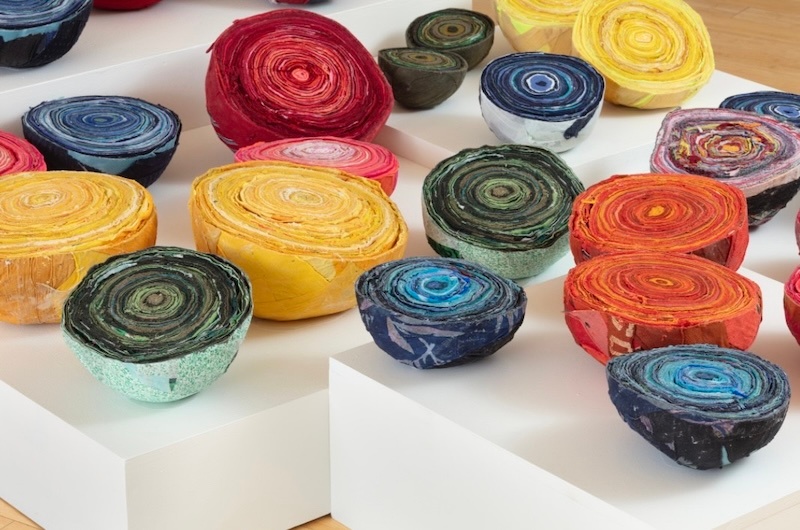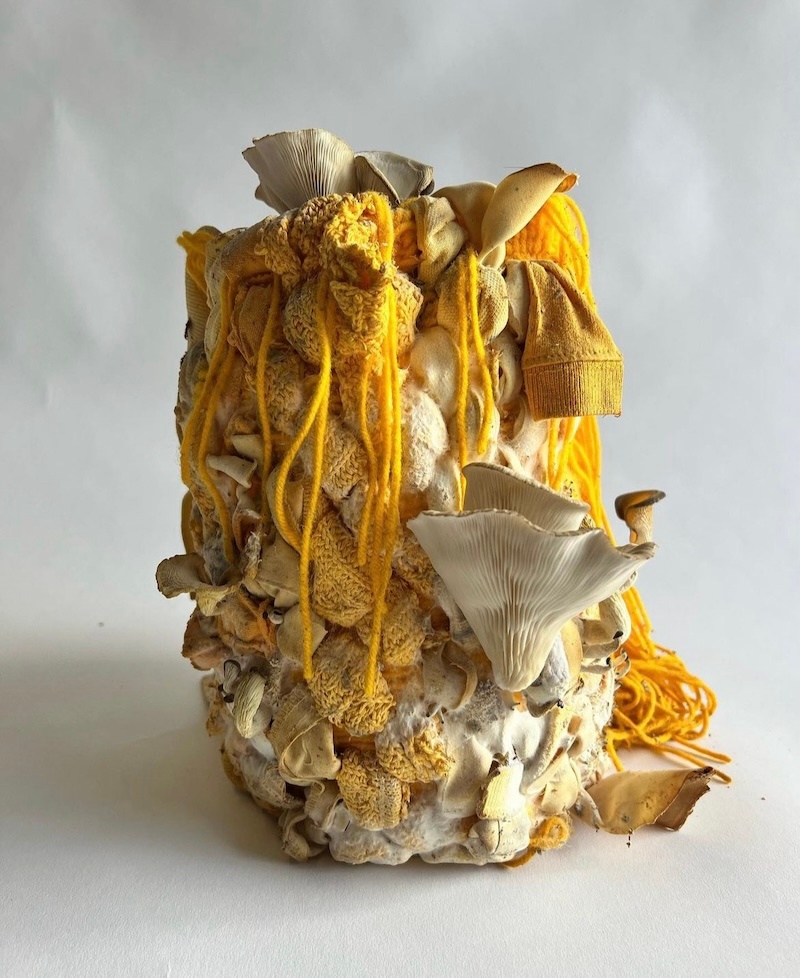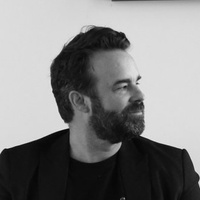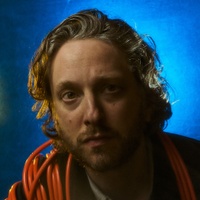On engaging with the world in your work
Prelude
Minga Opazo is a fourth-generation textile crafter who explores the relationship between climate change, contemporary textile production, and Chilean textile history and design. Born in Chile, Minga immigrated to Los Angeles at the age of 16. Opazo’s recent works question the textile industry, exploring the idea of “solastalgia,” a term that describes the mental or existential distress caused by environmental change and living in an era of excess, constantly consuming, and throwing away. In her practice, she is dedicated to researching the textile industry further and to creating work that exposes, reflects, and finds a solution to the current situation of the textile waste industry. She has shown her work widely, been awarded with various residencies, and had her work featured in Artforum, Lum Art Magazine, and American Science.
Conversation
On engaging with the world in your work
Textile artist Minga Opazo discusses being confident, finding solutions, and balancing research with your artistic practice.
As told to Eva Recinos, 2255 words.
Tags: Art, Craft, Process, Failure, Collaboration, Identity, Politics.
I read that you grew up spending time in your mother’s clothing store and that you’re also a fourth generation textile crafter. I was wondering if you could tell me about this family and personal history.
I grew up in Chile and my grandma was the main crafter in the family—she still is—and she was a seamstress. She fixed clothing for people at her house. And then from there, my mom and my aunt learned from her. And then I learned from my mom, mostly focused on fashion, and fixing and making clothing…Then I started diving more into weaving and contemporary art on my own.
That was my background growing up in Chile. And then my mom’s store—her and my aunt opened [it] after learning from my grandma. They started selling clothing from a really early age, just making their own garments and selling them. And that grew into a boutique, and then that grew into me going there after school to work for them and help them out in the store..
This was back in the ‘90s, and it was fun to explore my own fashion, but also understand how much work goes into making a garment. It’s interesting to me because now, with fast fashion, there’s no appreciation of the labor. I know how much it takes to make a garment and how much thought goes into it, from even making the material to the design and the labor.
The issues of landfills and waste, specifically in Chile but also globally, come up often in your work. I wonder if you could talk about these topics and how you grew your awareness around them.
Chile’s one of the countries that receives “donations”of clothing, but they’re really not donations, they’re trash. Ghana is another country that receives [imports of secondhand clothing]. They’re the main countries that receive textile waste. It’s so much waste, and so much clothing. A lot of it is very useful but Chile, now, is a country that’s deeply rooted in capitalism, and we have H&M and Zara and all of these things. The culture is very consumerism-based. People are not going to use used clothing, mostly they go to H&M and Zara and buy cheap, fast fashion. So we have this massive amount of textile waste. It’s in the desert and there’s a lot of people that are trying to do something about it, but there’s just so much clothing.

How do you balance your research and staying informed with your artistic process?
I went to UC Berkeley. It’s very research-based and I think I learned from an early age, or undergrad age, to be research-based. I make work and then I do research and I go back and forth, and sometimes a day in the studio is just doing research. Sometimes the studio day is just making work. It depends on where I’m at and if some of my friends send me an article or I dive into that. Having access to university research is really important to me and I do [have access] because I’m an alumni at Berkeley.
I’d love to know a little bit about what your studio looks like. Is it a space where you have your research in front of you? I also know that a lot of your work requires you to collect scraps of materials.
I work in Ojai and it’s a warehouse space. It doesn’t have insulation or anything like that, so I’m really with nature here. It’s in the countryside. I’m always balancing bugs and stuff. All the clothing that I have right now, I have it because during my master’s at CalArts, I started doing this whole research about textile waste. I went to thrift shops in Ventura and they pack thousand-pound bales of clothing and they send it to Africa and Chile.
I asked them if I could have one of those bales, and they’re like, “sure.” Then, I had another one after that. I’m still working from those 2,000 pounds of clothing—so much clothing. On top of that, people just give me clothing because they prefer to give it to me than just [throwing it in] the trash. I’m still working with that. Basically, my studio has rows of clothing that I’ve been organizing by color. And then I have a little mushroom lab area where I do my mushroom work.

You mentioned that you organize all this material by color. There are a lot of layers to your pieces. Do you normally sketch out what you think the pieces are going to look like or do you have moments of discovery while you’re making them?
Both. When I have a sculpture that I have very clear in my head, usually they’re large sculptures and I work making molds, and then I make the layers of clothing. And then I have to sketch out the mold and how I’m going to cut it and work in the woodshop and stuff like that.
But also, one of the reasons that I got into growing mushrooms into my sculptures and having grass into my sculptures is that when I made one of the first sculptures, there were layers of mud and clothing. I made it with dirt from the outside. It was already outside my studio. And it started naturally growing because it was wet. I only used natural materials when I made these sculptures. It started naturally growing grass. And so then, that illuminated me to be like, “Oh, what happens if I start growing stuff in my sculptures?” And having this conceptual moment between nature and the sculptures…The pieces do what they want to do. So it’s a collaboration between nature and my work.

I was reading that one of the approaches you’re taking is seeing how the fungi can turn textile waste into regenerative soil. When did that idea come up in your work?
After grad school, all my work was about showing the problem with textile waste and the textile industry in general and showing how it is from the beginning to the end. All my work was [about] exposing the textile industry. I still do that in my work because I grew up with textiles, and I just think it’s the natural resources that from the beginning to the end, it’s a problem, basically. And then [around] COVID, I was sitting back and I had more time to think about my work. For me as an artist, I was like, “Okay, I’m showing the problem, but there’s got to be a solution out there, or at least some hope out there how we can deal with this.” I started doing research. I came across this article of fungi used in oil spills and then discoveries of them working on eating plastic…I ran into a friend and colleague, her name is Danielle Stevenson. She’s a PhD [candidate] in [environmental] toxicology at UC Riverside. But her main thing is about fungi and microbial remediation and I asked her “What happens if we mix some mushrooms with the clothing? Would [the mushrooms] eat it?” And she was like, “Yeah, let’s try it.”
She advised me in my first project of putting mycelium in between clothing and seeing what happens, and it started working out. We are still talking and collaborating, but mostly I’m doing my sculptures. The whole idea behind it is that I’m doing research and trying to figure out a solution. Conceptually, I’m trying to move beyond just showing the problem.
I love that you mentioned collaborating with experts in very different fields. Do you have advice or insights for artists in terms of how you approach folks or maybe research folks in these very different areas to then inform your art?
Right now, we have so many ways to reach out to people through social media and email and stuff like that. And just proposing to these scientists like, “Hey, I’m actually working on this. Do you have time? Or do you like to have a call about it?” Or just reaching out and also experimenting yourself. There’s a lot of things that I learned through YouTube, to be honest. There’s so much information out there… You just have to just do the research. And then once you have some kind of results, and something’s interesting to you, then you start reaching out to people that are experts in their field. Usually, scientists are very similar to artists, in my opinion, because they’re very passionate about what they’re researching and doing. If you have something really interesting to show to the scientists, they’re going to be interested in it.

In interviews, you’ve said that you use YouTube a lot and you like using a range of materials, and teaching yourself rather than taking more traditional approaches. I was wondering if you could tell me a little bit about that.
I’m very motivated to just figure it out. I taught myself how to weave through YouTube at the beginning. And then I went to Haystack, a residency in Maine, and they had looms and people were there, and I just learned from them. I was just diving deep into something that’s interesting. In the world of DIY, people are putting so much information out there, and it’s exciting. You can explore and do stuff as an artist that you were just not able to do before, [when] you had to go to an institution to learn it.
I recently saw your work at Craft Contemporary, and it was part of a two person show with Maria A. Guzmán Capron. I’d love to hear your insights into the process of working on this two person show, and the similarities between your work.
I knew about Maria’s work, but it was really exciting because Alma Ruiz was the curator of our show and Alma paired us up. It was a nice surprise because I really liked the way that she uses textiles. And it is interesting that we both are using reused materials from the landfill and then putting it into museums and stuff like that and reorganizing, because I feel like a lot of artists just buy a lot of material and then spend all this money into it. And they’re all basically very toxic in general. Reusing materials is important for me and it is important for Maria.
Yeah. I know we talked a little bit about folks who are in science fields, but what about researching folks in the art community? What has your approach been to that?
I’m always researching different artists and, especially, artists who are using textiles and how they’re using them. The majority of my art community has been created through art residencies. I’ve been through a lot of them, and it’s funny how they all connect to each other in some way or the other. Art residencies are really important to build a community. You get to be with this group of artists for 24 hours basically, and you go out with them. You build this big tie with them, and then you see them grow in different ways as an artist throughout the years. You were hanging out in this place that is not your home, is far away from people, and you create this bond that’s very strong.
How do you deal with “failure” or with detours in your work? What sort of insights do you have for artists in terms of that journey and just embracing it?
You have to get used to rejection and failure. I mean, it’s kind of wild that I choose this career, and I think every artist has that. All of my artist friends have this meltdown every other week of, “What am I doing with my life?” You just keep going because you’re passionate about it, to be honest. You get so close to getting this grant that you think is going to help you out a lot, and you’re around the corner from it, and then you get the rejection. You just have to have grit and just keep going. This is what you are meant to do, so you’re going to keep doing it. Sometimes I’ve talked to friends who are like, “I don’t know if I can keep going. I’m so afraid.” I’m like, “What else are you going to do?”
What are the other options?
What else are you going to do? You’re going to be incredibly unhappy with the other options, so might as well just keep going. It’s a hard career. There’s a lot of bad things about it, but there are also really good things about it. You have to get used to it and be confident in your work and what you’re doing. Just keep going in your studio and keep going.

Minga Opazo Recommends:
Morning dance parties are better than coffee
Always shop second hand clothing
Wash your clothing with cold water, they’ll last longer and it reduces microplastic going in to the water
Hanging out with friends, dogs and family is the best remedy for depression
Adventure is out there
- Name
- Minga Opazo
- Vocation
- textile artist
Some Things
Pagination



